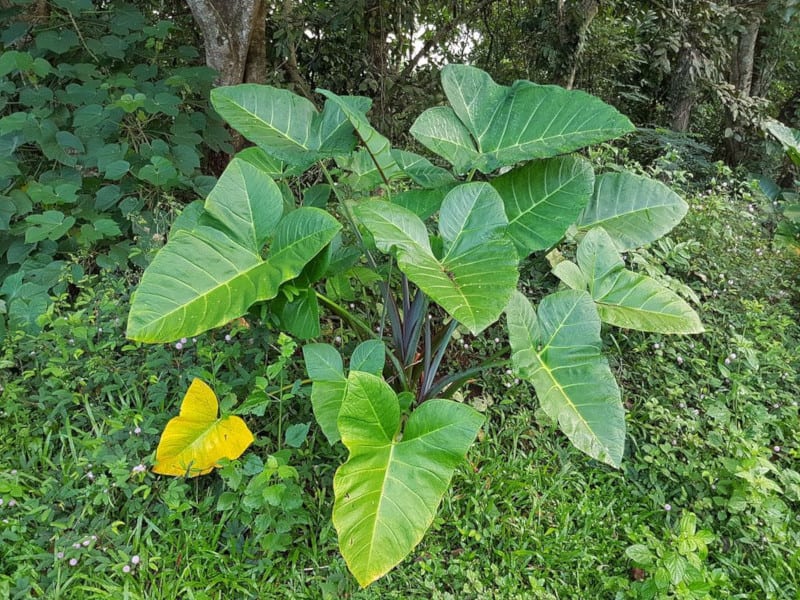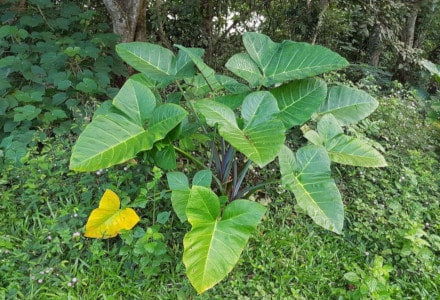
Arrowleaf Elephant Ear Facts
- The term Arrowleaf Elephant Ear serves as one of the common names for a visually surprising plant. It also goes by the alternate names of American taro, blue taro, and purple taro, however. Many cultivars also now exist in various parts of the world.
- But professional botanists may know it best by its official scientific name. That’s the all but unpronounceable term of Xanthosoma sagittifolium. Regardless of the name by which one knows it, though, it presents a strikingly distinctive structure to the observer.
- The popularity of the plant depends on perspectives, due to its nature. In some regions it’s widely cultivated as a food crop, for its leaves and tubers. It’s also often used in local efforts at reforestation, as a source of weed control, and as a shade provider.
- For others, though, it’s frequently seen as an invasive species, due to its ability to grow and spread rapidly. The Arrowleaf Elephant Ear can produce grown specimens from corms within 14 weeks. These can the produce 10 or more corms within 10 months.
- The IUCN presently has no listing for this amazing plant on its Red List. This occurs due its presence in dozens of countries around the world, as well as its reproductive capacities. Nonetheless, like most species, it remains vulnerable to climate change.
Related Articles
Arrowleaf Elephant Ear Physical Description
The most readily apparent physical characteristic of the Arrowleaf Elephant Ear needs no clarification. That’s due to the fact that the sheer size of the plant in general cannot be mistaken. Some specimens, in fact, attain a vertical measurement of up to 9 ft (2.7 m)
It’s the foliage of the plant, though, that takes this principle to the next level. Each individual leaf sometimes reaches lengths of as much as 6.6 ft (2 m)! Relative to the height of the plant, this size, along with their shape, causes many to compare them to the ears of an elephant.
The enormous leaves present a dark green upper surface, along with a lighter shade on the underside. These further develop atop relatively slender, long stems protruding from the thick, fleshy base. Each specimen also produces multiples of these stems and leaves.
Amazingly, the Arrowleaf Elephant Ear sometimes spreads via aerial roots that it produces. It also achieves pollination through the combined actions of bees, flies, and beetles. The edible corm the Angiosperm produces serves as a natural storage location for nutrients.
- Kingdom: Plantae
- Phylum: Tracheophytes
- Class: Monocotyledonae
- Order: Alismatales
- Family: Araceae
- Genus: Xanthosoma
- Species: X. sagittifoilum
Arrowleaf Elephant Ear Distribution, Habitat, and Ecology
While the Arrowleaf Elephant Ear now appears in many regions of the world, its exact origins remain something of a mystery. The most precise estimate researchers can manage places its origins somewhere in the northern regions of the continent of South America.
More exactly, the theorized general area of its evolution includes what now forms the countries of Peru, Colombia, Venezuela, and Ecuador. Not surprisingly, therefore, its native habitat consists of regions of relatively dense, warm, and humid tropical forests.
Even within such regions, though, the Arrowleaf Elephant Ear, like many species, has certain preferences. In its case, the Angiosperm appears natively most commonly on the banks of streams, and in shaded areas. It nevertheless has remarkable adaptability.
For that reason, it appears, even in its native region, at virtually all altitudes. In portions of the globe it has spread to, it appears in diverse habitats. These include areas of pinelands, wet ditches, wetlands, and even along the outlying borders of swamps.
This species, widely used in cultivation, appears in the local cuisines of many countries. Furthermore, it does so in a vast array of forms. These include pastes, stews, soups, and even served in manners similar to a potato. Both the corm and leaves have nutritional value.
Species Sharing Its Range
Check out our other articles on 5 Geological Marvels of Arizona, Ring-Tailed Cat, Hyacinth Macaw, Saint Mary’s Islands, Bowmouth Guitarfish, Conehead Mantis, Jackson’s Chameleon

